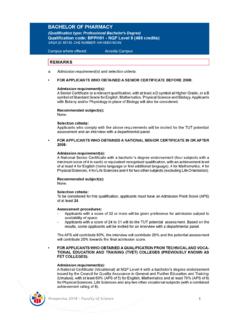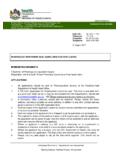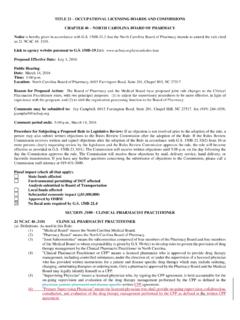Transcription of Risk Evaluation and Mitigation ... - Pharmacy Tech Topics
1 Home-Study Continuing Pharmacy Education Modules for Pharmacy TechniciansJanuary 2012 Volume 17 Number 1 This module must be successfully completed by January 31, 2014 to receive CPE Credit. Pharmacy Tech Topics is provided as a free service to all Pharmacy Technician Members of the American Society of Health-System Evaluation and Mitigation Strategies (REMS) Pharmacy Tech Topics Volume 17 No. 1 January 2012 Risk Evaluation and Mitigation Strategies (REMS) AUTHOR: Michael A. Fotis, BSPharmEDITOR: Patricia M. Wegner, BSPharm, PharmD, FASHPDESIGN EDITOR: Stephanie LammiPharmacy Tech Topics (USPS No. 014-766) is published quarterly for $50 per year by the Illinois Council of Health-System Pharmacists, 4055 N.
2 Perryville Road, Loves Park, IL 61111-8653. Phone 815-227-9292. Periodicals Postage Paid at Rockford, IL and additional mailing offices. POSTMASTER: Send address changes to: Pharmacy Tech Topics , c/o ICHP, 4055 N. Perryville Road, Loves Park, IL 61111-8653 All contents 2012 Illinois Council of Health-System Pharmacists unless otherwise noted. All rights reserved. Pharmacy Tech Topics is a trademark of the Illinois Council of Health-System Pharmacists. This module is accredited for contact hours of law continuing Pharmacy education and is recognized by the Pharmacy Technician Certification Board (PTCB). LEARNING OBJECTIVESUpon completion of this module, the subscriber will be able to:1. Define risk Evaluation and Mitigation strategies (REMS) and their purpose.
3 2. Identify at least 3 internet sites that provide timely information about REMS medications and Identify the challenges and benefits REMS present health system Pharmacy Explain practical approaches such as including the Pharmacy and Therapeutics (P&T) committee to enhance REMS implementation in health : Pharmacy Tech Topics Modules are accredited for Continuing Pharmacy Education (CPE) credits by the Illinois Council of Health-System Pharmacists. The Illinois Council of Health-System Pharmacists is accredited by the Accreditation Council for Pharmacy Education as a provider of continuing Pharmacy education. The intended audi-ence is Pharmacy technicians. 2012 Illinois Council of Health-System Pharmacists.
4 Pharmacy Tech Topics is a trademark of the Illinois Council of Health-System Pharmacists. This module will provide contact hours of law continuing Pharmacy education credit for Pharmacy Universal Activity Number: 0121-0000-12-001-H03-T Type of Activity: Knowledge-basedValidation Dates: 1/01/12 to 1/31/14 Pharmacy TECH TOPICSTM JANUARY 20122 Pharmacy Tech Topics January 2012 Faculty DisclosureIt is the policy of the Illinois Council of Health-System Pharmacists (ICHP) to insure balance and objectivity in all its individually or jointly presented continuing Pharmacy education programs. All faculty participating in any ICHP continuing Pharmacy education programs are expected to disclose any real or apparent conflict(s) of interest that may have any bearing on the subject matter of the continuing Pharmacy education program.
5 Disclosure pertains to relationships with any pharmaceutical companies, biomedical device manufacturers, or other corporations whose products or services are related to the subject matter of the intent of disclosure is not to prevent the use of faculty with a potential conflict of interest from authoring a publication but to let the readers know about the relationship prior to participation in the continuing Pharmacy education activity. It is intended to identify financial interests and affiliations so that, with full disclosure of the facts, the readers may form their own judgments about the content of the learning activity. Mr. Fotis submission has been peer reviewed with consideration and knowledge of these potential conflicts and it has been found to be balanced and objective.
6 The author has no real or apparent conflict(s) of interest that may have any bearing on the subject matter of this continuing Pharmacy education is an ever-changing science. As new research and clinical experience broaden our knowledge, changes in treatment and drug therapy are required. The author and the publisher of this work have checked with sources believed to be reliable in their efforts to provide infor-mation that is complete and generally in accord with the standards accepted at the time of publication. However, in view of the possibility of human error or changes in medical sciences, neither the author nor the publisher nor any other party who has been involved in the preparation or publication of this work warrants that the information contained herein is in every respect accurate or complete, and they are not responsible for any errors or omissions or for the results obtained from use of such information.
7 Readers are encouraged to confirm the information contained herein with other sources. For example and in particular, readers are advised to check the product information sheet included in the package of each drug they plan to administer to be certain that the information contained in this module is accurate and that changes have not been made in the recom-mended dose or in the contraindications for administration. This recommendation is of particular importance in connection with new or infrequently used Evaluation and Mitigation Strategies (REMS)3 Meet the AuthorMichael A. Fotis, BSPharmResidency PGY1 Director / Manager for Drug InformationNorthwestern Memorial HospitalChicago, Illinois Michael Fotis is the PGY1 Residency Director and the manager for Drug Information at Northwestern Memorial Hospital in Chicago, Illinois.
8 He is the author of more than 40 publications and 100 presentations, covering Topics such as medica-tion safety, drug use policy, leadership, mentoring, and REMS. He graduated with honors from the University of Illinois at Chicago College of Pharmacy with a bachelor of science degree in Pharmacy and also holds a degree in psychology. He was recently named Alumnus of the Year by the University of Evaluation and Mitigation Strategies (REMS)A Culture of SafetyRisk Evaluation and Mitigation Strategies (REMS) are in-tended to lead the way to a much safer medication use sys-tem than we have currently. Before describing the REMS program, a short discussion about medication safety and also about adverse drug reactions is in order.
9 A recent study, Temporal trends in rates of patient harm resulting from medical care, published in 2010 in the New England Journal of Medicine1 found no improvement in patient safety more than 10 years after the Institute of Medicine s report To err is human published in 19992 raised the profile of medical errors for practitioners, the public, and our government. The New England Journal retrospective study of ten North Caro-lina hospitals measured the occurrence of adverse events and applied an internationally recognized scale to assess these adverse events for harm caused. This assessment for harm was confirmed by two reviewers. It was expected that the advances in automation put in place over the ten plus years since 1999 including computer prescribing, implementing evidence based care, and restricting the hours of medical residents would lead to a measurably safer health system.
10 In this study, more than 2,300 patient cases were reviewed and harm was identified 25 times for every one hundred admis-sions. After further analysis, the authors concluded there was no difference between the rates of harm in this 2010 study when compared to the Institute of Medicine 1999 report. The FDA was encouraged by a number of public health ex-perts to take a more active role in supporting medication safety and the REMS programs were developed as a result of these concerns. As healthcare providers, as patients, or as family members, we cannot continue to tolerate this lack of progress. Clearly it is about time we do something effective to improve medication REMS programs can be viewed as part of an overall con-cept termed a Culture of Safety.









